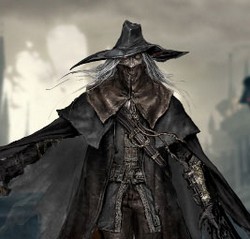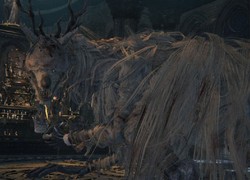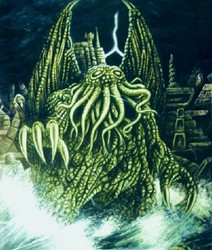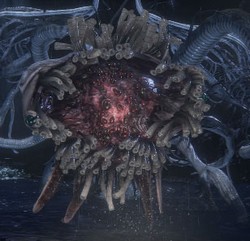In 2021, on the sixth anniversary of Bloodborne’s release, tens of thousands of players on internet forums like Reddit have congregated to create their very own co-operative online event within the game.
The six years since Bloodborne’s release on the PlayStation 4 have seen quite little decline in the player base; a remarkable feat for a game that came out so early in the console’s life.
The Return to Yharnam (“Yharnam” being the fictional Victorian England analogue in which the game takes place) event, which was organized entirely by the game’s player community, celebrates both this six-year milestone and the enduring lifespan of Bloodborne’s active player base. From March 24 to April 7, players, known as Hunters, will be actively searching for player-versus-player duels to test their skills against other devoted fans.
 This year, right before the Return to Yharnam, I happened to play Bloodborne for the first time. I was expecting a challenge, as the title is notorious for its emphasis on incredibly difficult bosses. As I joined the Hunt during such an active period in the game’s lifespan, I thought this would be a great moment to reflect on Bloodborne, one of the most ingenious pieces of horror fiction in the past decade.
This year, right before the Return to Yharnam, I happened to play Bloodborne for the first time. I was expecting a challenge, as the title is notorious for its emphasis on incredibly difficult bosses. As I joined the Hunt during such an active period in the game’s lifespan, I thought this would be a great moment to reflect on Bloodborne, one of the most ingenious pieces of horror fiction in the past decade.
At first glance, Bloodborne seemed like a Victorian-era monster-slaying RPG: heavily promoted were gory images of elegantly dressed Brits hacking and slashing beast and vampires, the promotional content conjuring up memories of classic first-wave horror movies like Dracula and Frankenstein.
Beneath the surface, though, I found that this Gothic fantasy was more of a conduit for something more celestial and much deeper than any promotional art ever divulged. Bloodborne begins in Yharnam, a city where the people have been turning into beasts as a result of a mysterious affliction. Dropped into the game in the middle of the chaos of “the Hunt”—a night when members of Yharnam’s Healing Church walk the streets to destroy traces of the infection in lethal ways—the player is tasked with, essentially, figuring out what the hell is going on.
 However, the game centers on the concept of “insight;” by gaining insight, the Hunter begins to uncover the true nature of Yharnam and the blood-borne disease transforming its citizens and clergy into beasts. Like in real life, insight is a valuable asset in Bloodborne. Unlike in real life, the more insight you have, the more apparent the horrifying and positively Lovecraftian nature of Yharnam becomes to you.
However, the game centers on the concept of “insight;” by gaining insight, the Hunter begins to uncover the true nature of Yharnam and the blood-borne disease transforming its citizens and clergy into beasts. Like in real life, insight is a valuable asset in Bloodborne. Unlike in real life, the more insight you have, the more apparent the horrifying and positively Lovecraftian nature of Yharnam becomes to you.
Insight can also be a curse, though. At certain insight levels in the game, the Hunter (and, therefore, the player) becomes hyper-aware of just how twisted the things that are happening in Yharnam are. An item which grants insight, called the “Madman’s Knowledge,” is usable if the player requires, but the item’s name invokes a feeling that, maybe, if madness is engendered by such knowledge ignorance truly is bliss.
In a complete subversion of the classic horror vibe that was established by the first chapter of the game, Bloodborne soon evolves into a complex tale filled with lore about the Great Ones, incomprehensibly powerful astral beings similar to H.P. Lovecraft’s “Elder Gods” (Cthulhu being perhaps the most famous of these).
 The player learns, as the game’s story descends into madness, that the citizens of Yharnam are actually being infected with the ancient blood of these so-called Great Ones, which was discovered hidden deep beneath the city’s surface, in a decrepit labyrinth.
The player learns, as the game’s story descends into madness, that the citizens of Yharnam are actually being infected with the ancient blood of these so-called Great Ones, which was discovered hidden deep beneath the city’s surface, in a decrepit labyrinth.
Unbeknownst to both the Healing Church and the people, the Church has been administering this blood to citizens to forge covenant with the Great Ones, causing all who have partaken to transform into hideous beasts; take Vicar Amelia, for example, a young priestess of the Healing Church who becomes a huge canine monster with gnarled antlers as a result of being “treated” with the blood of beings akin to gods.
Not only is Bloodborne a masterpiece of celestial fiction; it’s a powerful example of how initial perceptions of media can be deceiving. In horror, this is especially effective.
Bloodborne on its face presents as a bleak Victorian monster story, but our perception is distorted as we gain insight and find out the true nature of Yharnam and its plague. The Hunter starts out fighting werewolves, angry mobs, feral dogs, and zombies, but the enemies become increasingly more ethereal, otherworldly, and difficult to handle. Eventually, in true Lovecraftian fashion, you graduate to slaying beings that are revered as gods from another dimension.
H.P. Lovecraft was a pioneer of this astral horror, creating dozens of unique and omnipotent creatures in an attempt to trivialize humanity’s place in the universe: by giving credence to the mere idea that these fantastical interdimensional deities exist—even in a strange fictional universe—Lovecraft was able to question reality and the philosophical implications of a higher power. Works in the mythos H.P. Lovecraft created are produced by dedicated authors to this day.
Bloodborne is a love letter to H.P. Lovecraft, through and through. However, by not presenting itself in such a manner outright, and through meticulous design, a unique aesthetic, and a heaping helping of difficulty, the game is also able to maintain its individuality. It’s no small feat to complete Bloodborne from start to finish. It’s the hardest game I’ve ever played in the amount of focus and tenacity required to finish it.
I daresay it’s worth it. There are few things more satisfying than, for example, slaying the Blood-Starved Beast after 40-something attempts and more than a few strategy changes. It’s not for the faint of heart, but it is for people highly interested in a unique story; it doesn’t get much more unique than many of these concepts. Bloodborne provided a challenge unlike any other available in 2015, and the Return to Yharnam community event is a mark of the enduring enjoyment players still get from the game.
All things considered, it’s no wonder that, after six years, the active player base of Bloodborne is as bloodthirsty as ever. If you’re taking part in Return to Yharnam and the commemoration of Bloodborne’s anniversary: happy hunting!
To all others: may the good blood guide your way.
IMAGE TAKEN from Bloodborne.fandom.com
IMAGE TAKEN from GamesRadar
IMAGE TAKEN from Bloodborne.fandom.com
IMAGE TAKEN from GameSpot




